The Arctic and Alaska
Polar Bear Listed in Endangered Species Act, but U.S. Government Limits Its Protection
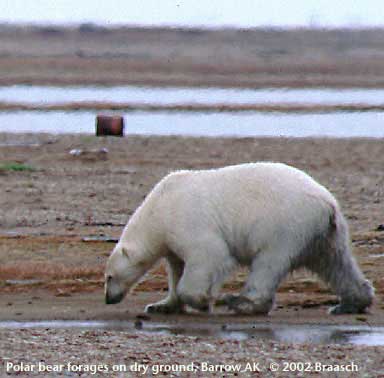
The polar bear was officially listed as threatened under the U.S. endangered species act (ESA) on May 14, 2008. This the first creature brought under the act's protection for habitat loss that is linked to global warming. The official reason given was loss of Arctic sea ice and predictions that the ice will continue to decrease. Although global warming has been identified by most atmospheric and polar scientists as the main reason for Arctic warming and melting of sea ice, the U.S. Interior Department under the Bush Administration did not use man-made global warming as a reason and clearly signaled it would not apply the law to greenhouse gas emissions.
Dirk Kempthorne, Interior Secretary at the time, specifically said the listing would not prevent any sea ice from melting and that he would "make certain the ESA isn't abused to make global warming policies." This despite clear language in the ESA to control any activity causing harm to a listed species and requiring government agencies specifically not to jeopardize species by their actions. The wording of the listing document appeared to be an attempt of the Bush appointee to list the bear due to clear evidence of shrinking habitat yet not take all the steps to limit the loss. It seems analogous to President Bush's notorious "signing statements" limiting his acceptance of a Congressional law.
The Obama Administration did not immediately move to change this interpretation, and it remains the subject of a lawsuit filed by environmental groups. But in October 2009, the Obama Interior Department it said it would "designate critical habitat for polar bear populations in the United States under the Endangered Species Act of 1973 [over] approximately 519,403 square kilometers (200,541 square miles)," with a final announcement to come after public comment in 2010.
"Threatened" under the ESA means a plant or animal may soon become
"endangered" (at immediate risk of going extinct) if actions are not
taken to protect it and its habitat.
The Kempthorne ruling in 2008 sent up a flurry of court challenges, not only by resource
extraction industries and groups seeking to reverse the whole listing,
but also by NGOs like the Center for Biological Diversity (CBD) which
originally brought the proposal. The CBD, NRDC and Greenpeace took the
Interior Dept to court twice to get action on the ruling in the first
place, and now are suing to advance critical habitat and enforce all
the provisions of the Endangered Species Act. These groups claim the
Secretary of the Interior violated the Act by listing the polar bear
only as “threatened” rather than “endangered” and by issuing a special
rule exempting greenhouse gas emissions and oil development from
regulation under the Act. That case is continuing.
The reduction of the permanent
Arctic sea ice by 14 percent since the 1970s is causing not only feeding
and breeding difficulties, but also drownings and apparent cannibalism
among bears. Government scientists have predicted rapid declines of
bears in all but the most northern of the range..
Information on this ruling may be found on websites of the CBD www.biologicaldiversity.org, and the US Interior Department at http://www.fws.gov/home/feature/2008/polarbear012308/polarbearspromo.html
Below and on linking pages, are reports on the latest science and warming effects across Alaska and parts of the Arctic. For more on Arctic natives, please see the Arctic page. Also see Glaciers for more on Greenland and Alaska glaciers.
Pushing the Boundaries of Life: Alaska
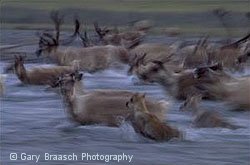
The listing of polar bears as threatened under the U.S. endangered species act will name global warming as the main threat, a first. The reduction of the permanent Arctic sea ice by 14 percent since the 1970s is causing not only feeding and breeding difficulties, but also drownings and apparent cannibalism among bears. The listing should be official by the end of 2007. For more information, see Center for Biological Diversity. Scientists are just beginning to see the effects of climate change on other Arctic wildlife. Caribou give birth at specific times and locations, making them susceptible to changes in weather and vegetation. Studies show that the tundra is now blooming slightly earlier and that it is affected by drier summers and
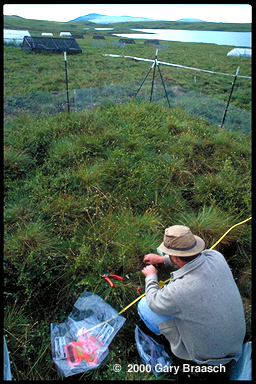
Gus Shaver at one of his experimental plots at Toolik Lake, Alaska, monitors increased birch growth due to experimental fertilization and global warming. Shaver says the results of his experiment suggest that warming eventually will promote the growth of birch at the expense of sedges, forbs, and other plants that caribou and other wildlife favor as food sources. During an initial 15-year study (1981-95, which included the warmest decade on record) the sedge Eriophorum decreased by 30 percent while birch biomass increased, even in control plots. In 2002 Shaver reports the growth of birch has changed the ecology of tundra in some
The great loss of ice from the Arctic, which includes not only the polar sea ice cover but also thawing glaciers and tundra permafrost, has other major implications. One of the most important is that dark open water and tundra absorb much more solar heat than white ice and snow. This is a "feedback loop" that will make changes happen faster.
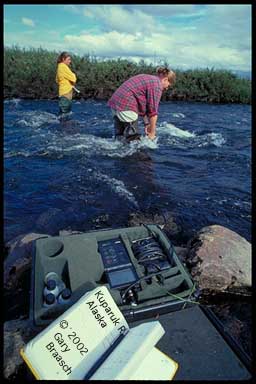
Another large effect in the Arctic is a freshening of the Arctic Ocean. In late 2002, geochemist Bruce Peterson of the Marine Biological Lab in Woods Hole, MA, and his collaborators in the US and Russia, showed that the major rivers of Siberia and Eurasia are discharging much more water now than in the 1930s. This not only meets the predictions of an effect of climate change, but indicates the scale of change affecting the Arctic.
In late 2002, geochemist Bruce Peterson of the Marine Biological Lab in Woods Hole, MA, and his collaborators in the US and Russia, showed that the major rivers of Siberia and Eurasia are discharging much more water now than in the 1930s. This not only meets the predictions of an effect of climate change, but indicates the scale of another source of added fresh water into the Arctic.
So what is happening to all this fresh water from increased river flow, melting glaciers and shrinking sea ice? It mixes into the Arctic Ocean and the less salty Arctic water flows south around Greenland, to the source of some of the greatest ocean currents.
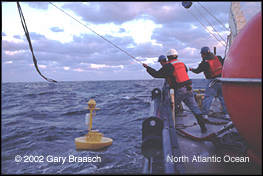
The interplay of ocean currents in the North Atlantic is very important to climate. Here, between Labrador and Scandinavia, the Gulf Stream brings a huge flow of water from the south, helping warm Europe as it gives up its heat. This water sinks as it cools, to flow back south again in the deep Atlantic. This plunging down of millions of tons of water per second helps propel what has been termed the Great Ocean Conveyor, a system of huge currents transferring heat throughout all oceans and influencing climate.
One key to this system is that the Gulf Stream water becomes more dense as it gives up heat, and it sinks. But the added fresher water coming down from the Arctic is much less dense, and floats on top of the North Atlantic.
Is there enough new fresher water from the Arctic to prevent the Gulf Stream water from sinking to help drive the conveyor of currents? According to recent studies by Dr. Ruth Curry and colleages at Woods Hole Oceanographic Institute, there is more fresher water in the area than ever measured before. Already sinking rates in some locations are 20 percent less than in the 1970s.
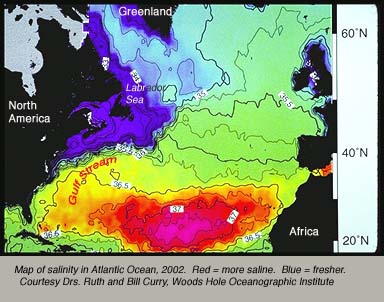
The northern waters are getting fresher while the southern waters (near equator) are increasing in salinity. Curry says this indicates a change in the climate with more precipitation and ice melt in the north and much stronger evaporation in the south. In other words: "Global warming."
Scientists are concerned that the point at which the current Conveyor does begin to slow may be near. Other current research shows the Gulf Stream is not the prime moderator of European temperature (westerly winds play a larger role). Yet climate in Europe and NE North America could chill if the ocean current slows dramatically. This is the jumping off point for a recent Pentagon planning report about possible international unrest caused by climate change, and for the movie "The Day After Tommorow." Scientists say disruptive change is coming -- but much more slowly than depicted in these scenarios.
More Climate Change in Alaska 2 >>
Photographs from the World View of Global Warming are available for license to publications needing science photography, environmental groups and agencies, and other uses. Stock photography and assignments available.
Use of photographs in any manner, in part or whole, without permission is prohibited by US copyright law. These photographs are registered with the US Copyright Office and are not in the Public Domain.
COPYRIGHT NOTICE:
Photography and text Copyright © 2005 - 2017 (and before) Gary Braasch All rights reserved. Use of photographs in any manner without permission is prohibited by US copyright law. Photography is available for license to publications and other uses. Please contact requestinformation@worldviewofglobalwarming.org. View more of Gary Braasch's photography here.


